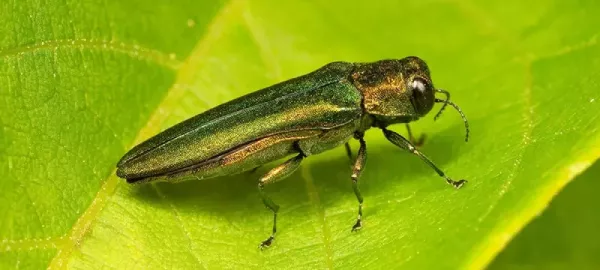The emerald ash borer is a small, metallic-green insect that has caused devastating ecological and economic impacts by infesting and killing millions of ash trees.
The relentless spread of the Emerald Ash Borer continues to pose a serious challenge for arborists, foresters, and conservationists as they strive to protect ash tree populations from this relentless invader.

Continue reading to learn more about the dangers caused by this invasive species and the importance of safeguarding Ash trees in the United States.
Is the Emerald Ash Borer Harmful?
Yes, the Emerald Ash Borer is highly harmful. This invasive beetle poses a significant threat to ash trees in the regions it has infested.
The adult beetles lay their eggs on the bark of ash trees, and once the larvae hatch, they burrow beneath the bark, disrupting the tree’s nutrient and water transport system.
As a result, affected trees gradually weaken, leading to canopy dieback and eventual death.
The widespread mortality of ash trees disrupts ecosystems and negatively impacts various wildlife species dependent on these trees for habitat and food sources.
Additionally, the economic implications are substantial, with the costs of managing and controlling the pest, along with the loss of revenue from industries relying on ash wood
How Does The Emerald Ash Borer Harm Ecosystems?
The negative effects on ecosystems are as follows:
Tree Mortality:
Infested ash trees gradually weaken and die, leading to a decline in trees The loss of ash trees alters the structure and composition of forested areas and disrupts natural habitats for various species.
Habitat Loss:
Many wildlife species, including birds, mammals, and insects, rely on ash trees for nesting sites, and food sources, and The decline of ash trees directly affects these species, leading to potential declines in their populations or forcing them to adapt to new habitats.
Altered Nutrient Cycling:
Dead and dying ash trees contribute less organic matter to the forest floor, affecting nutrient cycling This can impact soil fertility and the overall health of the forest ecosystem.
Invasive Species Promotion:
The decline of ash trees can create gaps in the forest canopy, providing opportunities for invasive plant species to establish and spread, further disrupting native
Biodiversity Loss:
Ash trees support a diverse range of insects and other organisms. When these trees are lost due to Emerald Ash Borer infestations, it can lead to a decline in the diversity of dependent species, affecting the overall biodiversity of the
Ecological Interactions:
The loss of ash trees can disrupt complex ecological interactions between species, potentially impacting predator-prey relationships and other important ecological
Can a tree with Emerald Ash Borer Be Saved?
According to the Emerald Ash Borer experts at American Turf & Tree Care, a tree infested with Emerald Ash Borer (EAB) can be saved in some cases, but it largely depends on the severity of the infestation and the overall health of the tree.
Read Also :
Early detection and prompt action are crucial for increasing the chances of success in saving an infested tree.
Here are some potential methods used to save ash trees from Emerald Ash Borer:
Insecticide Treatment:
Arborists may use insecticides to treat infested trees. Systemic insecticides injected into the tree or applied to the soil are absorbed by the tree, providing protection against This treatment can be effective in controlling the beetle population and preventing further damage.
Biological Control:
Introducing natural enemies of the Emerald Ash Borer, such as certain parasitoid wasps, can help control the pest population and reduce its impact on ash trees.
Pruning and Removal of Infested Branches:
Removing and destroying heavily infested branches can help slow down the spread of the beetles and provide the tree with a better chance of recovery.
Tree Health Care:
Ensuring the overall health of the tree through proper watering, fertilization, and other care practices can increase its resilience to the EAB attack and aid in recovery.
However, it is important to note that not all infested trees can be saved. If the infestation is too advanced, or the tree is already severely weakened or compromised, it may be too late for any treatment to be effective.
In such cases, the tree may become hazardous and need to be removed to prevent safety risks, especially if it is located near structures or high-traffic areas.
Early detection, regular monitoring, and consulting with a certified arborist or tree care professional are essential for determining the best course of action for an EAB-infested tree.
Additionally, proactive measures to prevent EAB infestations, such as restricting the movement of firewood and planting diverse tree species, can play a crucial role in preserving ash tree populations.
Where is the Emerald Ash Borer Most Common?
The Emerald Ash Borer is most common in the Midwest, Northeast, and Mid-Atlantic regions of the United States.
Some of the states with significant EAB populations include Colorado, Ohio, Indiana, Illinois, Wisconsin, Pennsylvania, and New York, among others.
Where Did Emerald Ash Borer Come From?
The emerald ash borer is native to eastern Asia, including China, Japan, Mongolia, Korea, and the Russian Far East.
However, since its accidental introduction to North America, likely through wood packaging materials, it has spread rapidly and become a significant invasive pest.
Can you prevent emerald ash borer?
While it is challenging to completely prevent the introduction of the Emerald Ash Borer (EAB) into new areas, there are measures that can be taken to reduce its spread and limit its impact on ash trees.
Here are some strategies to help prevent the infestation and spread of the EAB:
Restrict Movement of Firewood:
One of the primary ways the EAB spreads is through the transport of infested firewood. Avoid moving firewood from one area to another, especially across long Instead, purchase and burn firewood locally to prevent introducing the beetle to new locations.
Quarantine and Monitoring:
When an EAB infestation is detected in a new area, implementing quarantine measures can help limit the movement of ash wood and potentially infected Regular monitoring of ash trees in high-risk areas can aid in early detection and swift action to prevent further spread.
Regulations and Public Awareness:
Governments and environmental agencies can implement regulations and conduct awareness campaigns to inform the public about the risks of EAB and the importance of preventing its spread. Educating citizens about the dangers of moving firewood and the signs of EAB infestations can encourage responsible behavior.
Diverse Tree Planting:
Encourage planting a diverse range of tree species instead of relying heavily on ash trees. A diverse urban and forest landscape is more resilient to invasive pests and diseases.
It is important to consult with a professional arborist or a local forestry or agriculture department for the best prevention tactics and results.
Additionally, promoting the overall health and vigor of ash trees can help them withstand infestations.









